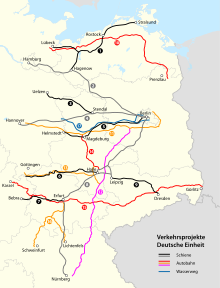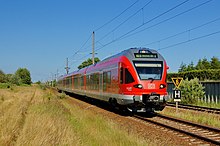Stralsund – Rostock railway line
The Stralsund – Rostock railway connects the two Hanseatic cities in the north of Mecklenburg-Western Pomerania . The single-track and electrified main line is part of the German Unity No. 1 transport project (Lübeck – Rostock – Stralsund).
history
Track construction and development until 1950
The railway line was built to create a direct railway connection between the two Hanseatic cities of Rostock and Stralsund and to open up the area in between. Prussia envisaged a single-track main line, Mecklenburg considered a branch line to be sufficient. The concession was granted by a state treaty on December 15, 1884. The line was built by the Prussian State Railways and officially opened on July 1, 1888 from Stralsund to Ribnitz and on June 1, 1889 from there to Rostock. The Mecklenburg state only contributed financially. The route crossed the border between the Grand Duchy of Mecklenburg-Schwerin and the Prussian province of Pomerania between Ribnitz and Damgarten . The original planning provided that the Stralsund – Ribnitz section would be led via Barth . This piece had already been measured . However, the shorter connection via Velgast was chosen to reduce construction costs .
Operational management on Prussian territory, i.e. from Stralsund to Damgarten, was initially carried out by the Prussian State Railway, and operations on the Mecklenburg section were carried out by the Mecklenburg Friedrich-Franz Railway . The necessary change of locomotives took place in the Ribnitz train station (today: Ribnitz-Damgarten West). After the restoration of the Prussian locomotives in Rostock, Mecklenburg, had been regulated by a state treaty, operations were completely transferred to the Prussian State Railroad. The line was the last to serve the Rostock Friedrich-Franz-Bahnhof , the later freight yard, southeast of the old town. On May 1, 1906, the direct connection to Rostock Central Station went into operation.
In the course of the following years, additional branch lines developed along the route. Connections to Prerow via Barth ( Darßbahn of the Prussian state railways), Tribsees ( Franzburger Südbahn ) and Graal-Müritz ( Mecklenburgische Bäderbahn ) were created. As a result of these extensions by branch lines, the Rövershagen and Velgast stations developed into railway hubs . The Velgast train station in particular gained particular importance due to the connections to Prerow and Tribsees.
The line, initially built as a branch line, was upgraded to the main line in 1926.
1950-1989
During the GDR era, the route was extended in many places by military and factory connections. At the end of the 1950s, the Rostock overseas port was built north of the route , which was linked to the Stralsund route with connecting routes in the direction of Rostock and Bentwisch.
The industrial railway to the fertilizer plant in Poppendorf is an important connection . Military purposes were served by the sidings from Ribnitz-Damgarten Ost to Pütnitz (airfield) and from Gelbensande to Schwarzenpfost , which ran parallel to the forest a few meters alongside the main line. The fibreboard plant in Ribnitz was also connected to a works railway.
From 1985, the gradual electrification of the line began in the following stages:
- Rostock Hauptbahnhof - Rostock freight yard: December 15, 1985
- Riekdahl - Bentwisch: April 12, 1986
- Bentwisch - Poppendorf: May 30, 1986
- Bentwisch - Stralsund: June 2, 1991
On March 29, 1985, the last scheduled steam train ran on this route.
1990 to 2010
After the fall of the Wall in 1989, many connections and station facilities were no longer used, and were later partially dismantled (Rostock freight station). The connections for the NVA military trains were no longer needed and were completely dismantled, the Schwarzenpfost, Altheide , Langenhanshagen , Starkow and Pantelitz stops have not been served since 1996. In addition, the last local freight train ran in 1996 .
In 1999 the section between Ribnitz-Damgarten West and Stralsund was completely renovated. The appearance of the stations along the route changed significantly. The signal boxes were replaced by a new electronic signal box (ESTW) in Velgast. As a result, all signal box buildings, freight and sidings that were no longer needed were demolished and the old signal box technology housed in the station buildings was removed. Most of the remaining buildings are empty and have been secured against unauthorized entry. The closed breakpoints were completely removed in the course of the renovation. For this purpose, a new stop was opened in Stralsund-Grünhufe after the route was renovated.
The renovation of the rest of the section between Rostock and Ribnitz-Damgarten West has started, but has been suspended repeatedly so far. Therefore, the route on this section is almost completely in an older condition. All stations are still occupied. In the course of the renovation, the section between Rostock and Ribnitz-Damgarten West should be expanded to double-track due to the current high density of trains. There were also plans to retrofit a second track on the Velgast – Stralsund section. All culverts and bridges were laid out for a second track in 1999. According to the result of the review of the requirement plan for the federal railways on November 11, 2010, the project will not be pursued any further because of its unfavorable cost-benefit ratio.
Construction work
In March 2007 the first construction work was carried out to upgrade the Rostock - Ribnitz-Damgarten West section to 160 km / h. Major construction work was carried out here, especially in the Bentwisch, Gelbensande and Ribnitz-Damgarten West train stations. Further construction work took place in spring 2008. Additional platforms along the route were renovated and guard rails and freight tracks in the stations were removed. The western section of the route will not yet be connected to the Velgast ESTW.
passenger traffic
Local transport
Trains on the RE9 Rostock– Sassnitz line run every two hours on the route . Since December 2007, Stadler-Flirt railcars have operated on the route , which, thanks to their greater acceleration and higher speed, enable shorter travel times on some sections of the route. Before they were used, trains ran, which mostly consisted of three double-decker cars and a class 143 locomotive . The RE9 has been operated by the Ostdeutsche Eisenbahn-Gesellschaft (ODEG) since 2019 . ODEG uses Desiro ML railcars for this.
On the Rostock - Rövershagen section, there is an additional RB12 train every hour in the direction of Graal-Müritz . The Rostock-Kassebohm, Bentwisch and Mönchhagen stops served by the RB12 are usually not served by the regional express trains in the direction of Stralsund. Class 642 ("Desiro") railcars are used in the direction of Graal-Müritz . Until 2017, the Usedomer Bäderbahn (UBB) ran trains between Stralsund and Velgast with class 646 railcars every two hours . These continued to operate on the UBB route network to Barth . Since they only run between Velgast and Barth, but almost every hour, the Kummerow stop (near Stralsund) is no longer served.
By the end of 2022 , a stop called Rövershagen - Karl's Adventure Village is to be built in the Purkshof district of Rövershagen , which will primarily serve the visitors and employees of the amusement park of the same name . The forecast is for 80,000 travelers per year and costs of up to 1.3 million euros.
Long-distance transport
The route is used several times a day by long-distance trains. The ICE trains stop at Rostock Hbf , Ribnitz-Damgarten West , Velgast and Stralsund Hbf stations . Some trains continue from Stralsund to the Baltic Sea resort of Binz on Rügen . The long-distance trains create connections to Hamburg and the Ruhr area . Until October 2007, a night train ran from Stralsund to Munich and the Ruhr area. In summer, a train from Dortmund to Sassnitz was regularly on offer on the route , bringing holidaymakers from the Ruhr area to the Baltic Sea quickly and comfortably. Another seasonal Intercity ran until 2016 as " UrlaubsExpress Mecklenburg-Vorpommern " from Cologne via Hamburg, Rostock and Stralsund to the island of Usedom in the seaside resort of Heringsdorf .
A special feature of the tariff on this route is that all long-distance trains between Rostock and Stralsund can be used with local transport tickets or for free transport with severely handicapped ID cards. However, this does not apply to country tickets .
Since the timetable change in 2005, there is no longer a pure two-hour cycle on the route. The reason for this is the shortening of the downtime of long-distance trains in Hamburg Hbf, which can only be achieved in this way. In order to accelerate local traffic and to be able to offer the long-required through trains from Rostock Hbf to Rügen, it was necessary to change the crossing stops of the trains. Now the long-distance trains are waiting for the local trains.
Freight transport
The route is of great importance for freight transport in the region, but also nationwide. The large freight stations at Rostock Seehafen and Sassnitz-Mukran on Rügen are served. There are also two plant connections : the largest plant connection is the fertilizer plant in Poppendorf. It has its own works station. Yara Rostock has been serving the sidings and works station in Poppendorf for some time . The other connection is in Rövershagen, through which a local gas provider is supplied.
Virtual replica of the route
The entire route appeared in 2005 as an add-on for the Microsoft Train Simulator . The add-on is the track under construction in the early 1990s and is under the name - of "German Railroads Volume 6 along the Baltic Sea" German Railroads sold. When designing the route, emphasis was placed on a high degree of reality. This is how all branch lines and works connections were shown.
In September 2007, another add-on was published by German Railroads, which also includes the route, it is called "German Railroads Volume 9 - With the Reichsbahn to Rügen". This time the line represents the state of the early 1980s. Therefore, the overhead line and works connection to Poppendorf do not yet exist, but there are many sidings at the subway stations that were dismantled in the 1980s. In addition, this time the route will continue to the island of Rügen, where all standard gauge routes are displayed.
- route
literature
- Detlef Radke: 150 years of railways in Mecklenburg . Radke, Schwerin 1997, ISBN 3-932614-00-3 .
Web links
- Stralsund – Rostock railway line on ostseestrecke.de
Individual evidence
- ^ German Bundestag (ed.): Transport investment report for the reporting year 2012 . Informed by the Federal Government (= printed matter . No. 18/580 ). Bundesanzeiger Verlagsgesellschaft mbH, February 18, 2014, ISSN 0722-8333 , p. 36–37 ( dipbt.bundestag.de [PDF; 66.2 MB ; accessed on February 24, 2014]).
- ↑ From 2022: Own train stop for Karl's adventure village in Rövershagen. In: Ostsee-Zeitung . April 15, 2019, accessed April 16, 2019 .
















